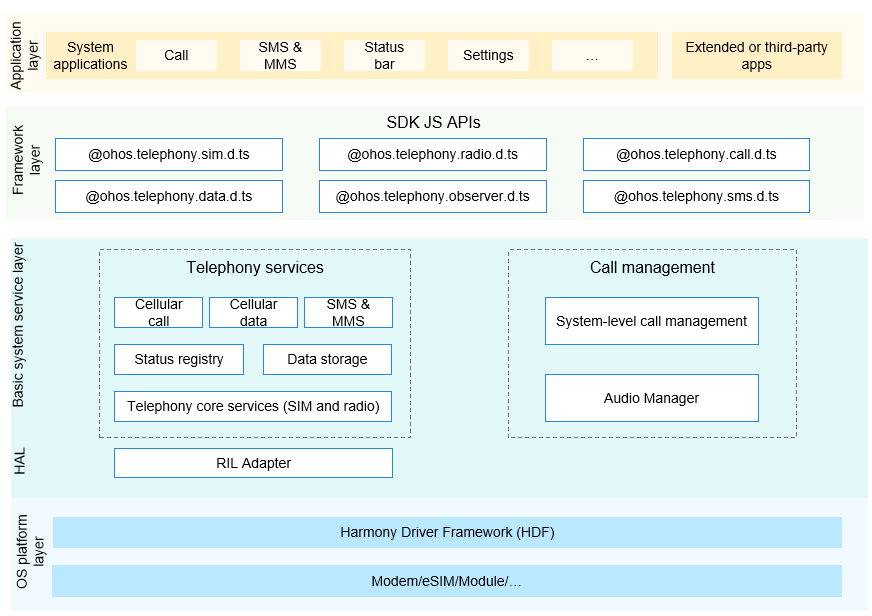harmony 鸿蒙Telephony
Telephony
Introduction
The Telephony subsystem provides APIs for obtaining information about the wireless cellular network and SIM card. Applications can call these APIs to obtain information such as the name of the currently registered network, network service status, signal strength, and SIM card information.
The Telephony subsystem consists of the following modules:
- Telephony core service: initializes the Radio Interface Layer (RIL) Manager, SIM card module, and radio module.
- Call Manager module: manages three types of calls – circuit switched (CS), IP multimedia subsystem (IMS), and over the top (OTT) calls. It is responsible for applying for the audio and video resources required for a call and resolving conflicts in a multi-channel call.
- Cellular call module: implements basic calls over carrier networks.
- Cellular data module: implements cellular data services over carrier networks.
- SMS & MMS module: provides the capabilities of sending and receiving short message service (SMS) messages and encoding and decoding multimedia messaging service (MMS) messages.
- State registry module: provides APIs to register and deregister an observer that listens for various callback events of the telephony subsystem.
- Data storage module: stores persistent data and provides DataAbility access APIs.
- RIL Adapter module: implements adaptation of the modem communication interfaces.
Figure 1 Architecture of the network management subsystem

Directory Structure
base/telephony/
├── core_service # Telephony core service
├── call_manager # Call Manager module
├── cellular_call # Cellular call module
├── cellular_data # Cellular data module
├── sms_mms # SMS & MMS module
├── state_registry # State registry module
├── data_storage # Data storage module
└── ril_adapter # RIL Adapter
Constraints
- The open-source version currently provides the cellular call (CS call only), SMS & MMS, and cellular data services and supports the dual-SIM framework.
- The southbound HDI depends on the chip vendor. For details, see Telephony Service Southbound Development Guide.
Usage
To learn more about the usage of each subsystem module, refer to the respective README. The following illustrates API usage by exemplifying how to obtain the current cellular network signal information and observe the cellular network status changes.
Obtaining the Current Cellular Network Signal Information
Import the radio namespace from @ohos.telephony.radio.d.ts.
Call getSignalInformation(slotId: number) in callback mode or call getSignalInformation(slotId: number) in promise mode.
Obtain the result from the SignalInformation array in the callback.
Traverse the SignalInformation array to obtain the signalLevel (signal strength) for each signalType (radio access technology).
// Import the http namespace. import radio from "@ohos.telephony.radio"; // Set the value of slotId. let slotId = 0; // Call the API in callback mode. radio.getSignalInformation(slotId, (err, value) => { if (err) { // If the API call fails, err is not empty. console.error(`failed to getSignalInformation because ${err.message}`); return; } // If the API call is successful, err is empty. for (let i = 0; i < value.length; i++) { console.log(`success to getSignalInformation: type is ${value[i].signalType}, level is ${value[i].signalLevel}`); } }); // Call the API in promise mode. let promise = radio.getSignalInformation(slotId); promise.then((value) => { // The API call is successful. for (let i = 0; i < value.length; i++) { console.log(`success to getSignalInformation: type is ${value[i].signalType}, level is ${value[i].signalLevel}`); } }).catch((err) => { // The API call fails. console.error(`failed to getSignalInformation because ${err.message}`); });
Observing Cellular Network Status Changes
Adding an Observer
Import the observer namespace from @ohos.telephony.observer.d.ts.
Call on(type:‘networkStateChange’) with slotId (optional) and callback specified.
Register an observer instance for callback events of network status changes.
// Import the http namespace. import observer from '@ohos.telephony.observer'; // Registers an observer. observer.on('networkStateChange', {slotId: 0}, (value) => { console.log(`network state is ` + value); });
Removing the Observer
Import the observer namespace from @ohos.telephony.observer.d.ts.
Call off(type: ‘networkStateChange’) with callback (optional) specified for a certain type of event.
// Import the http namespace. import observer from '@ohos.telephony.observer'; // Unregister the observer. observer.off('networkStateChange');
Repositories Involved
Telephony
你可能感兴趣的鸿蒙文章
harmony 鸿蒙DistributedDataManager Subsystem
harmony 鸿蒙System Ability Manager
- 所属分类: 后端技术
- 本文标签: